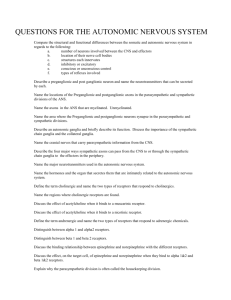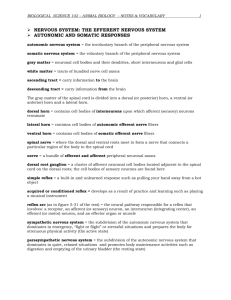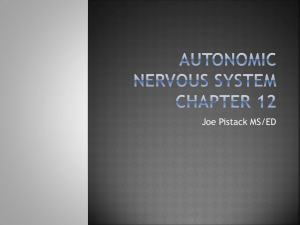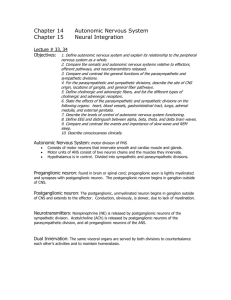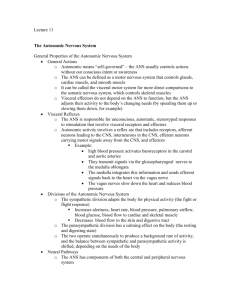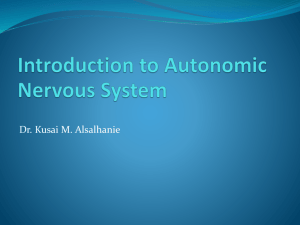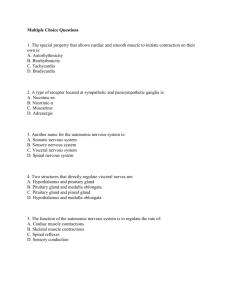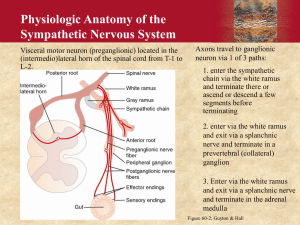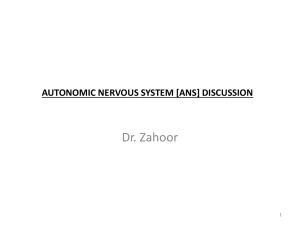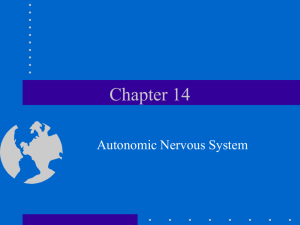AUTONOMIC NERVOUS SYSTEM
advertisement
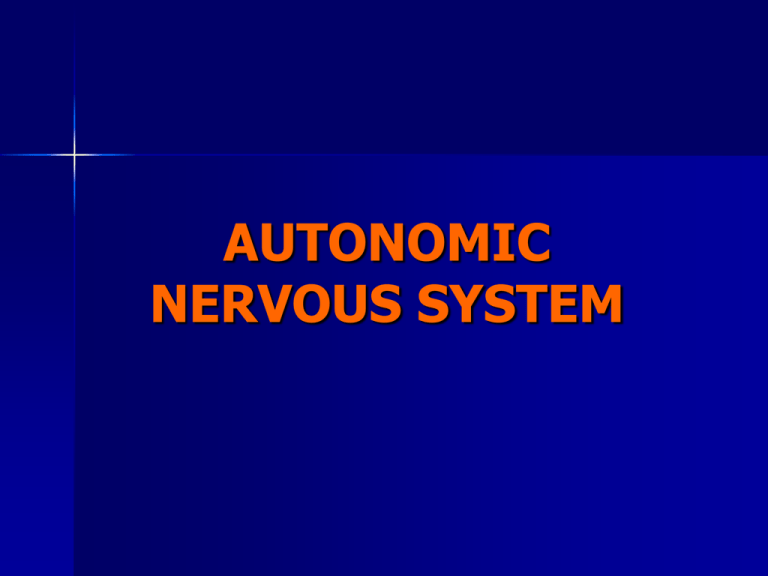
AUTONOMIC NERVOUS SYSTEM The autonomic system controls the visceral functions of the body: arterial pressure, gastrointestinal motility and secretion, urinary bladder emptying, sweating, body temperature, and many other activities. There are two major subdivisions in the autonomic nervous system: a) sympathetic nervous system, and b) parasympathetic nervous system. General scheme of the reflex arc of the autonomic nervous system receptor – afferent nerve fiber – nerve center – preganglionic efferent nerve fiber – peripheral ganglion – postganglionic efferent nerve fiber – visceral organ. Effectors Somatic nervous system – Skeletal muscles ANS – Cardiac muscle – Smooth muscle – Glands Efferent Pathways Somatic nervous system – A, thick, heavily myelinated somatic motor fiber makes up each pathway from the CNS to the muscle ANS pathway is a two-neuron chain 1. Preganglionic neuron (in CNS) has a thin, lightly myelinated preganglionic axon 2. Ganglionic neuron in autonomic ganglion has an unmyelinated postganglionic axon that extends to the effector organ Neurotransmitter Effects Somatic nervous system – All somatic motor neurons release acetylcholine (ACh) – Effects are always stimulatory ANS – Preganglionic fibers release ACh – Postganglionic fibers release norepinephrine or ACh at effectors – Effect is either stimulatory or inhibitory, depending on type of receptors Divisions of the ANS Sympathetic division 2. Parasympathetic division Dual innervations –Almost all visceral organs are served by both divisions, but they cause opposite effects 1. SYMPATHETIC NERVOUS SYSTEM Preganglionic neurons (sympathetic nerve centers) lie in the spinal cord from T-1 to L-2 segments (in the intermediolateral horn). Postganglionic neurons lie either in the two paravertebral sympathetic chains of ganglia or two prevertebral ganglia (the celiac and gipogastric). The postganglionic nerve fibers travel to their destinations in the various organs. Approximate distribution of the sympathetic innervation: From T-1 to the head From T-2 into the neck From T-3, 4, 5, 6 into the thorax From T-7, 8, 9, 10, 11 into the abdomen From T-12, L-1, 2 into the legs. Note: some sympathetic preganglionic nerve fibers pass all the way (without synapsing) from the spinal cord into the adrenal medullae. They end directly on modified neuronal cells that secrete epinerphine and norepinerphine into the blood stream. Role of the Sympathetic Division Mobilizes the body during activity; is the “fight-or-flight” system Promotes adjustments during exercise, or when threatened – Blood flow is shunted to skeletal muscles and heart – Bronchioles dilate – Liver releases glucose PARASYMPATHETIC NERVOUS SYSTEM a) b) Preganglionic neurons lie into the brain stem (nuclei of the cranial nerves III, VII, IX, and X) and into the sacral segments of the spinal cord. Postganglionic neurons lie in the wall of the innervated organs (except a few parasympathetic nerves). Postganglionic nerve fibers are short (from a few mm to cm). Role of the Parasympathetic Division Promotes maintenance activities and conserves body energy Its activity is illustrated in a person who relaxes, reading, after a meal – Blood pressure, heart rate, and respiratory rates are low – Gastrointestinal tract activity is high – Pupils are constricted and lenses are accommodated for close vision Distribution of parasympathetic innervation: III cranial nerve – ciliary ganglion – ciliary muscle of eye; papillary sphincter; VII cranial nerve – a) sphenopalatine ganglion – lacrimal glands; nasal glands; b) submandibular ganglion – submandibular glands; IX cranial nerve – optic ganglion – parotid gland; X cranial nerve – into the thorax and abdomen; Sacral segments of the spinal cord – into the pelvis (rectum, bladder). NEUROTRANSMITTERS: 1. All preganglionic neurons are cholinergic in both sympathetic and parasympathetic nervous systems; 2. All postganglionic neurons of the parasympathetic nervous system are cholinergic; 3. Most of the postganglionic neurons of the sympathetic nervous system are adrenergic; NOTE: postganglionic sympathetic nerve fibers to the sweat glands, the piloerector muscles and a few blood vessels are cholinergic as an exception. RECEPTORS FOR NEUROTRANSMITTERS There are two principle types of acetylcholine receptors in the postsynaptic membrane: 1. nicotinic receptors – in the synapses between preganglionic and postganglionic neurons of both the sympathetic and parasympathetic nervous systems; muscarinic receptors – between postganglionic parasympathetic nerve firbers and innervated cells. NOTE: specific drugs are used to stimulate or block one or the other of the two types of receptors 2. There are two major types of adrenergic receptors in the postsynaptic membrane of innervated cells: alpha-receptors (alpha-1 and alpha-2) and beta-receptors (beta-1 and beta-2). Norepinerphine and epinerphine have somewhat different effects in exciting the alpha- and betareceptors: = norepinerphine excites mainly alpha-receptors (and much less beta-receptors); = epinerphine excites both types of receptors equally. Effects are determined by the types of receptors in the organs. AUTONOMIC EFFECTS ON VARIOUS ORGANS OF THE BODY CONTROL OF BRAIN STEM AUTONOMIC CENTERS BY THE HYPOTHALAMUS Control of medullary cardiovascular centers; Controls body temperature (heat control); Feeding control; Control of salt and water balance. The hypothalamus sends output signals in three direction: – downwards to the brain stem, mainly into the reticular areas and then into the autonomic nervous system; – upward toward many higher areas of the diencephalons and cerebellum, especially to the anterior thalamus and limbic cortex; – into the infundibulum to control most of the secretary functions of both the posterior and anterior pituitary glands. The hypothalamus controls most of the vegetative and endocrine functions of the body as well as many aspects of emotional behavior. Developmental Aspects of the ANS During youth, ANS impairments are usually due to injury In old age, ANS efficiency declines, partially due to structural changes at preganglionic axon terminals Developmental Aspects of the ANS Effects of age on ANS – Constipation – Dry eyes – Frequent eye infections – Orthostatic hypotension Low blood pressure occurs because aging pressure receptors respond less to changes in blood pressure with changes in body position and because of slowed responses by sympathetic vasoconstrictor centers Role of the Autonomic nervous System in Exercise
